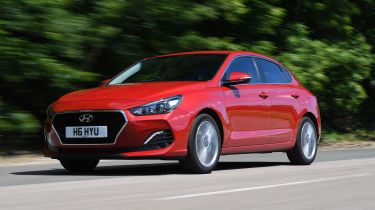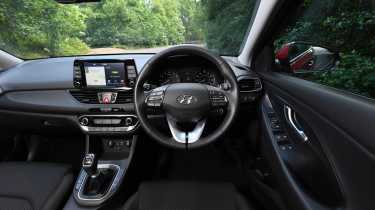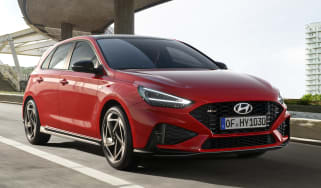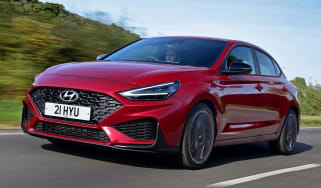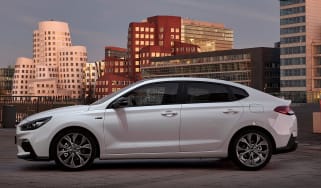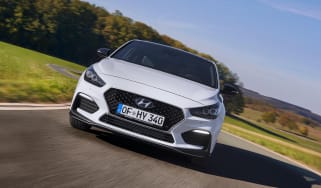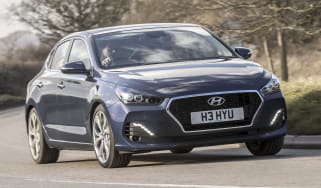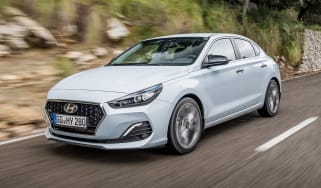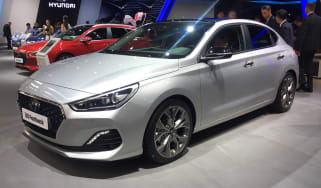Hyundai i30 Fastback review
The i30 Fastback adds some coupe style to the Hyundai compact hatchback formula

The Hyundai i30 Fastback brings some diversity to the crowded compact hatchback market, and is likely to attract interest from anyone looking for something other than a standard five-door hatchback. Whether or not they will find the i30 Fastback attractive is a personal thing. Where it really delivers in its all-round competence; there is a broad and efficient engine range, a high level of standard equipment and good build quality, a sound driving experience and competitive pricing, all of which makes for a compelling case on paper. What might be lacking is the spark of driving excitement that comes with a Ford Focus, or the superior quality feel of a Volkswagen Golf that might persuade buyers to sign on the dotted line.
The Hyundai i30 Fastback is the third model in the i30 range, and is for sale alongside the standard five-door i30 hatchback and i30 Tourer estate. It has the look of a coupe that aims to be a bit more stylish than the standard hatchback, but it also has additional space over the standard car.
It’s offered in SE Nav, Premium and Premium SE trims, while the range is topped by the rapid i30 Fastback N. These specs are the same as you’ll find in the standard i30 hatchback range, while the rest of the car’s running gear and technology is carried over, too.
Used - available now

2023 Honda
CR-V
29,496 milesAutomaticPetrol2.0L
Cash £25,447
2017 Mercedes
CLS Shooting Brake (2014-2017)
54,623 milesAutomaticDiesel3.0L
Cash £17,732
2023 Mercedes
CLA
15,800 milesAutomaticPetrol1.3L
Cash £23,807
2019 Jaguar
XE
64,100 milesAutomaticDiesel2.0L
Cash £11,200Only two engine options are available in the standard model, a 1.0-litre three-cylinder petrol with 119bhp and a 1.4-litre four-cylinder petrol with 138bhp, both of which are turbocharged. No diesel engine options are available, and both models come with a six-speed manual gearbox as standard. A seven-speed dual clutch automatic is available on the 1.4-litre engine only.
The i30 N Fastback uses the same mechanical make-up as the i30N hatchback, so it comes with a 2.0-litre four-cylinder turbocharged petrol engine offering 271bhp, and is matched to a six-speed manual transmission. A lower-output version of the i30N that is available in hatchback form, but it’s not available in the Fastback.
With a crowded compact hatchback market to contend with, the i30 Fastback offers something different to the norm. There’s no direct rival for it – the Mercedes A-Class Saloon is far more expensive – so the i30 Fastback has to rely on its unique looks to take sales from the main contenders in the compact hatchback segment such as the Ford Focus, Volkswagen Golf, Vauxhall Astra and the Kia Ceed. Kia also offers the Proceed model, which is closer to an estate car than a four-door coupe but combines a similar mix of a design-led exterior with boosted cabin space.
Engines, performance and drive
The Hyundai range generally provides an all-round competent driving experience, balancing comfort with driving pleasure, and the i30 Fastback largely follows this same template. The Fastback model has a number of detail changes compared to the hatchback model, notably the body shell is slightly stiffer and the suspension is fractionally lower and firmer, but for the standard model at least the emphasis is on delivering tidy handling and a comfortable ride.
The i30 Fastback copes well with all types of road, and while never excelling in one particular area, it is impressively capable and undemanding whatever the driving conditions. The standard six-speed manual gearbox has a smooth action while the brakes offer good stopping power and are easy to modulate, too. The steering is relatively heavy for a car with standard power assistance and the ratio of the rack is relatively slow, but it is as accurate and consistent as all the major controls, making it undemanding to operate for all kinds of drivers.
The i30 Fastback N moves this to another level, with significantly stiffer suspension, a unique gearbox, engine and electronic drive mode programme all taken from the i30N hatchback. While the ride is noticeably stiffer than the rest of the Fastback range, it’s not quite as stiff as the i30N hatch, and is all the better for it. What it does provide is satisfyingly-sharp steering responses and a good deal more excitement for the keen driver.
Engines, 0-60 acceleration and top speed
The entry-level i30 Fastback model comes with the 1.0-litre three cylinder turbocharged petrol offering 119bhp and 171Nm of torque. Although a keen engine that is willing to rev and is efficient, performance is modest with a 0-62mph time of 11.5 seconds and a top speed of 117mph. The 1.4-litre four-cylinder engine offers a better balance of abilities, with 138bhp and 242Nm of torque providing sufficient acceleration to achieve 0-62mph in 9.2 seconds and a top speed of 129mph. The four-cylinder engine is also a little more refined than the three cylinder unit, although the latter has a more pleasing sound when taken to higher revs.
The i30 Fastback N is a different animal, with 271bhp and 353Nm of torque enough to deliver 0-62mph in 6.1 seconds and a top speed of 155mph. That makes it a genuinely fast car, with rapid acceleration available instantaneously with an engaging exhaust note, particularly when one of the more aggressive drive modes is engaged.
MPG, CO2 and Running Costs
For a car of this size and a range that currently doesn’t include a diesel engine, the i30 Fastback offers impressive fuel consumption and CO2 performance. The smallest 1.0 T-GDi unit is inevitably the best performer in the range, with fuel economy as low as 47.1mpg combined under WLTP testing and 125g/km of CO2. The bigger 1.4-litre four cylinder engine offers useful extra power but it is quite close in respect of economy, with the version fitted with the seven-speed dual clutch DCT gearbox coming close to the 1.0 T-GDi at 46.3mpg combined and matching its 125g/km emissions figure. The worst-performing standard model is the 1.4-litre model with the manual gearbox which manages 45.6mpg and 132g/km of CO2, while the i30 N Fastback model is considerably less efficient with quoted WLTP figures of 35.3mpg combined and 178g/km emissions.
Insurance groups
Insurance rates for the i30 Fastback are competitive, with the SE Nav 1.0-litre model falling into group 8, and the most expensive 1.4-litre Premium SE model only in group 15. The high performance i30 N Fastback model is considerably higher at group 29, but this is relatively low for a car with this level of performance.
Depreciation
Hyundai has made solid progress in recent years of transforming its brand, taking it from being seen as offering low sticker prices and little else to one that still provides good value but that is able to compete on quality and ability too. This has helped improve the residual values of Hyundai products, although its products do still fall behind the best in class for residual values. The i30 Fastback has values edging close to 40 per cent, which is slightly better than the standard hatchback, but still a couple of per cent behind hatchback class leaders such as the VW Golf and Honda Civic.
To get an accurate valuation on a specific model check out our free car valuation tool...
Interior, design and technology
The changes to transform the i30 from a hatchback to the Fastback model are centred on the back of the car, with a lower roof line and a small increase in length at the rear giving a sleeker appearance. Whether this is a sufficient improvement on the standard car is a decision only the potential buyer can make; it is not radically different to the standard car, but if an i30 has been decided upon then the alternative appearance may be an attractive one.
Unlike some fastback five-door coupes that have frameless door glass, the i30 Fastback features fully framed windows, giving it an even closer resemblance to the standard hatchback.
Inside there is a straighforward carryover of design and components from the i30 hatchback, but this is no bad thing. The layout of the cabin is both sensible and attractive to the eye, while the materials used are of a good standard. Standard equipment is generous too, with sat-nav, Bluetooth with voice recognition, wireless phone charging and rear park assist with a rear-facing camera all included as standard. Premium models add dual-zone climate control, privacy glass and heated seats, while Premium SE includes a panoramic roof, leather seats and a heated steering wheel amongst other extras.
The i30 N Fastback builds on this still further, adding amongst other things sports seats and the five-mode vehicle dynamic system which changes the car’s behaviour depending on the conditions.
Sat-nav, stereo and infotainment
All i30 Fastback models come with an eight-inch infotainment system that includes satellite navigation, Apple CarPlay and Android Auto as standard. Voice control is fitted and a multifunction steering wheel allows you to control the screen without having to take your hands off the wheel. In addition, Premium models and above add a 4.2-inch display ahead of the driver and between the dials that can be configured to show a number of information sub-pages.
Practicality, comfort and boot space
The i30 Fastback is capable of carrying four adults comfortably, with the possibility of squeezing a fifth adult in the rear centre seat for short journeys. The driving position is good, with a broad range of adjustment for the seat and the wheel, while the infotainment and climate controls are well placed for easy access. All-round visibility is good, and although the rear view is reduced fractionally compared to the hatchback it’s not enough to significantly impact rearward visibility.
In terms of storage throughout the cabin, the i30 Fastback shows plenty of thought has been given to making the most of the available space. Each of the door bins is generous in size and depth, while the centre console cubby can swallow a decent amount of items. A ski hatch is fitted to all versions, too.
Dimensions and size
The i30 Fastback sits around the middle in terms of its relative size compared to its key rivals. It is 130mm shorter and 25mm lower than the Mazda 3 Fastback but shares its width, while it is considerably longer than the hatchback Ford Focus, as well as lower and narrower. The Kia Proceed, which is related to the i30 Fastback, is longer, wider and lower. In terms of boot space, the Hyundai is competitive, offering more space with the seats up than all bar the Kia Proceed.
Leg room, head room & passenger space
The change in the roofline of the Fastback compared to the hatchback i30 inevitably means something of a compromise in terms of space, although what is lost in respect of room for occupants is partially regained when it comes to the luggage area. Front seat passengers enjoy competitive head and leg room, and in the rear legroom is on a par with the hatchback. Where the Fastback loses out is rear headroom, with the sloping roof robbing occupants of some space. Anyone of six feet in height will find the headlining encroaching on them.
Boot space
Going some way to compensate is the increase in boot space, with the Fastback offering 450 litres, in comparison to the 395 litres available in the hatchback. That is still less than the i30 Estate however.
Reliability and Safety
The i30 Fastback hasn’t been tested by Euro NCAP, but its so closely-related to the i30 hatchback that its five-star crash test rating applies to the Fastback as well. This includes an 88% score for adult occupant protection, and 84% for child safety in the car, and there is little reason to expect the Fastback to perform any poorer than that.
It’s helped by the standard safety provision, again much of which is shared with the i30 hatchback. All models receive lane departure and forward collision warning systems, plus lane-keep assistance and autonomous emergency braking. Premium and Premium SE models add blind-spot monitoring and a rear cross-traffic alert system for added reassurance.
The i30 Fastback has not yet appeared in the Driver Power owner satisfaction survey as it is too new, but the brand has a whole performed well in the 2018 survey. The Tucson and i20 models made it into the top 75 ranking, with particularly strong results for reliability and build quality. Hyundai achieved 15th place overall out of 26 manufacturers, putting it ahead of rivals such as Ford and Vauxhall.
Warranty
Hyundai’s warranty is more generous than the norm, with a five-year, unlimited mileage warranty across its entire range. This represents a show of confidence in the quality and reliability of its products which should bring added reassurance to private buyers. This warranty coverage is matched by Toyota, while sister brand Kia edges ahead with a seven-year warranty, although it does have a 100,000 mile mileage limit, which might not suit some long distance drivers as much as Hyundai’s unlimited warranty.
Servicing
The servicing cost for the i30 Fastback is competitive, with a minor service costing approximately £135, rising to around £280 for a major service. Hyundai also offers a fixed-price servicing plan as well as a free annual check.
